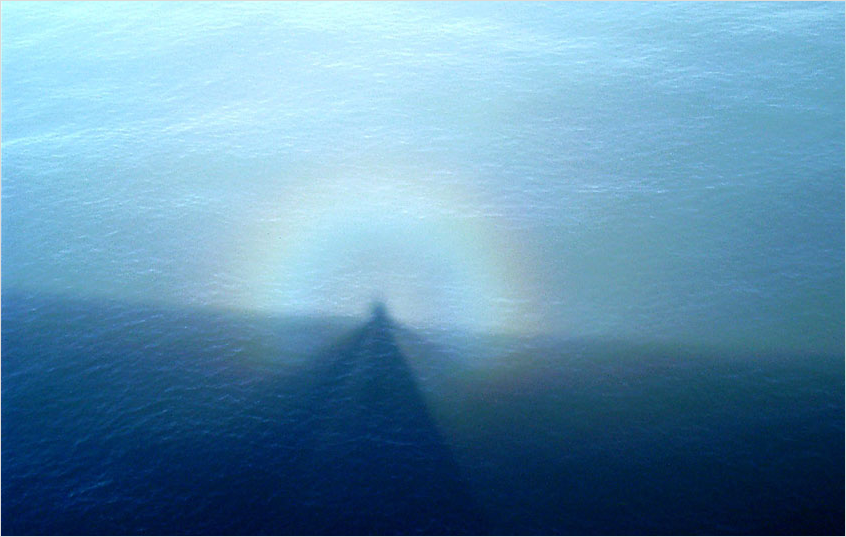Cruise Ship Glory & Brocken Spectre
Cruise Ship Glory & Brocken Spectre: A Mesmerizing Atmospheric Phenomenon
Have you ever been on a cruise ship and witnessed a breathtaking atmospheric spectacle? One such captivating phenomenon is the Cruise Ship Glory, which can be accompanied by the enigmatic Brocken Spectre. While cold weather and mountain mist are commonly associated with these optical wonders, they are not always necessary for their occurrence. In this article, we will delve into the fascinating world of Cruise Ship Glories and Brocken Spectres, exploring their formation, characteristics, and the awe-inspiring experience they offer.
What is a Cruise Ship Glory?
A Cruise Ship Glory is an atmospheric optical phenomenon that resembles a circular rainbow encircling the shadow of the observer's head, usually seen from a high vantage point on a ship. It is caused by the diffraction and interference of sunlight or moonlight by tiny water droplets in the air. The glory appears as a series of concentric rings, with the innermost ring being the most distinct and colorful. The colors of the glory are often arranged in reverse order compared to a traditional rainbow, with red on the inside and blue on the outside.
The Intriguing Brocken Spectre
Accompanying the Cruise Ship Glory, one may also witness the captivating Brocken Spectre. This optical phenomenon occurs when the observer's shadow is projected onto a cloud or fog bank below, creating a magnified and distorted shadow that appears to loom large in the sky. The Brocken Spectre is named after the Brocken mountain in Germany, where it was first observed and documented.
The Science Behind Cruise Ship Glories and Brocken Spectres
Cruise Ship Glories and Brocken Spectres are both formed through the interaction of light with water droplets in the atmosphere. When sunlight or moonlight passes through these droplets, it undergoes diffraction, which causes the light to spread out and form the rings of the glory. The size of the water droplets determines the size and intensity of the glory, with smaller droplets producing more vibrant colors.
The Brocken Spectre, on the other hand, occurs when the observer's shadow is cast onto a cloud or fog bank. As light passes through the droplets in the cloud, it is scattered in all directions, including towards the observer. This scattering creates the magnified and distorted shadow that appears to be surrounded by a halo of light.
Ideal Conditions for Cruise Ship Glories and Brocken Spectres
While cold weather and mountain mist are often associated with these phenomena, they are not essential for their occurrence. Cruise Ship Glories can be observed when there is a sufficient amount of mist generated by the contact between warm air and cooler sea. This mist acts as the medium for diffraction, allowing the glory to form.
Similarly, the presence of clouds or fog banks below the observer is necessary for the formation of a Brocken Spectre. When these conditions align, the observer's shadow is projected onto the cloud or fog bank, creating an ethereal and captivating spectacle.
Capturing the Beauty
If you find yourself fortunate enough to witness a Cruise Ship Glory and Brocken Spectre, capturing the beauty of these phenomena can be a rewarding experience. Here are a few tips to help you capture the moment:
- Use a camera with manual settings to adjust exposure and focus.
- Avoid using flash as it can wash out the colors and details.
- Experiment with different angles and perspectives to capture the full extent of the glory and spectre.
- Consider using a tripod to stabilize your camera and minimize blurriness.
The Magic of Atmospheric Optics
Cruise Ship Glories and Brocken Spectres are just two examples of the mesmerizing optical phenomena that can occur in our atmosphere. From rainbows and halos to sun pillars and auroras, our atmosphere never ceases to amaze us with its ability to transform light into breathtaking displays of color and light. These phenomena serve as a reminder of the beauty and complexity of the natural world, inviting us to pause and appreciate the wonders that surround us.
Conclusion
The world of atmospheric optics is filled with captivating phenomena, and Cruise Ship Glories and Brocken Spectres are no exception. Whether you find yourself on a cruise ship or in a mountainous region, keep an eye out for these enchanting displays of light and shadow. Witnessing a Cruise Ship Glory encircling your own shadow projected onto a cloud or fog bank is an experience that will leave you in awe of the natural world's beauty. So, next time you embark on a journey, don't forget to look up and marvel at the wonders that await you in the sky.

Cruise ship glory. Cold weather or mountain mist is not always necessary to see glories. Pat Lehnart saw this one from the ship's rail at Monterey California in September 2003. Contact between the warm air and cooler sea generated sufficient mist to produce the glory and show up the shadow paths of the Brocken spectre. ©Patricia Lehnart.
Note: this article has been automatically converted from the old site and may not appear as intended. You can find the original article here.
Reference Atmospheric Optics
If you use any of the definitions, information, or data presented on Atmospheric Optics, please copy the link or reference below to properly credit us as the reference source. Thank you!
-
<a href="https://atoptics.co.uk/blog/cruise-ship-glory-brocken-spectre/">Cruise Ship Glory & Brocken Spectre</a>
-
"Cruise Ship Glory & Brocken Spectre". Atmospheric Optics. Accessed on December 26, 2024. https://atoptics.co.uk/blog/cruise-ship-glory-brocken-spectre/.
-
"Cruise Ship Glory & Brocken Spectre". Atmospheric Optics, https://atoptics.co.uk/blog/cruise-ship-glory-brocken-spectre/. Accessed 26 December, 2024
-
Cruise Ship Glory & Brocken Spectre. Atmospheric Optics. Retrieved from https://atoptics.co.uk/blog/cruise-ship-glory-brocken-spectre/.